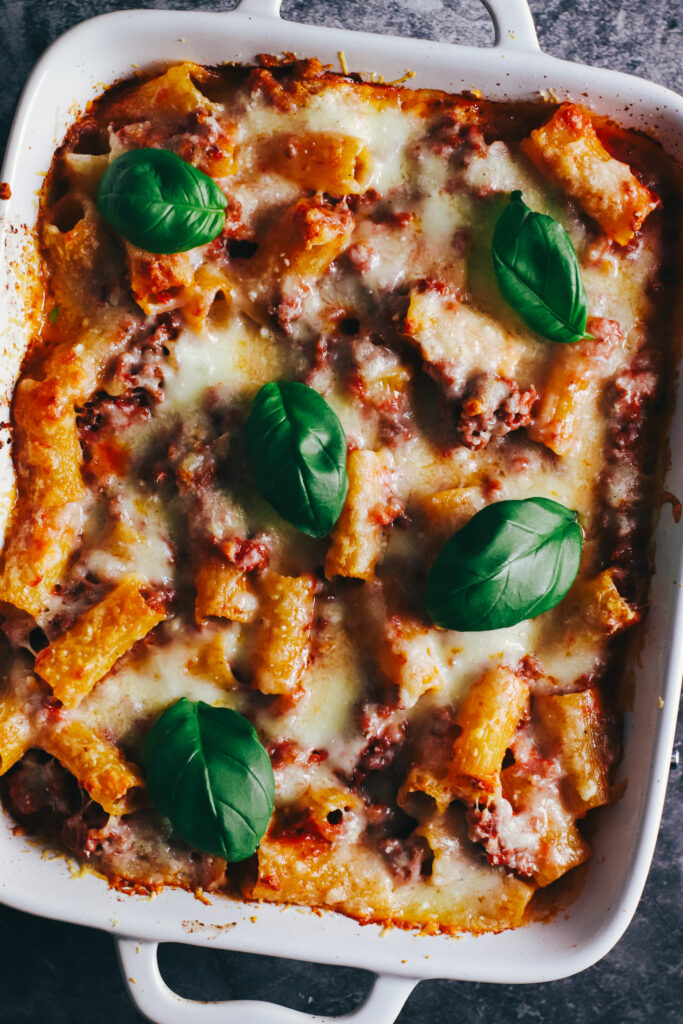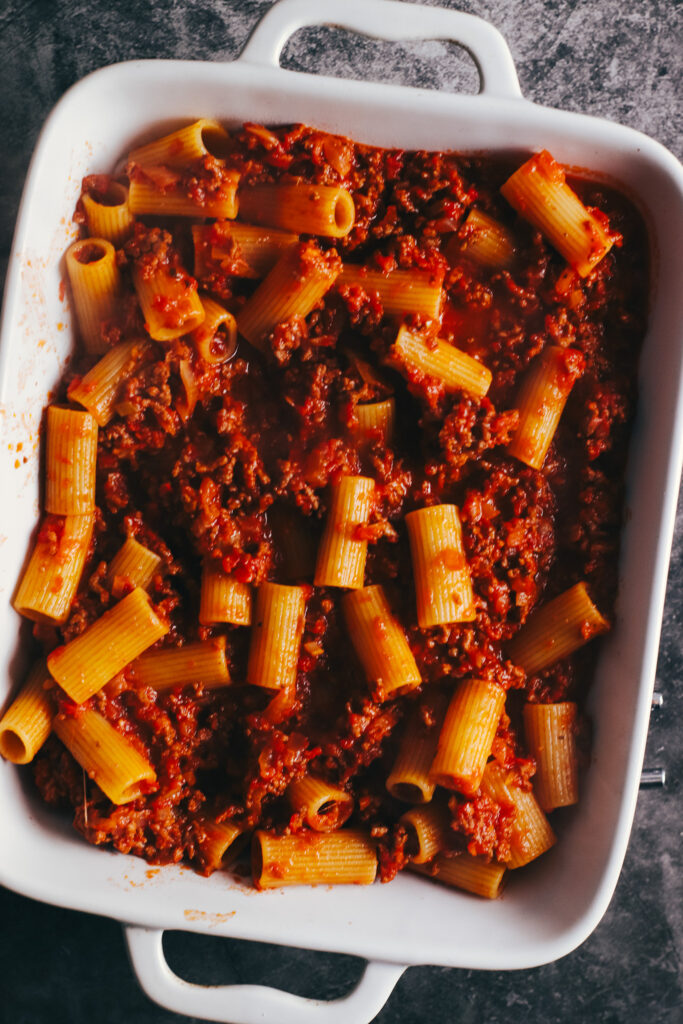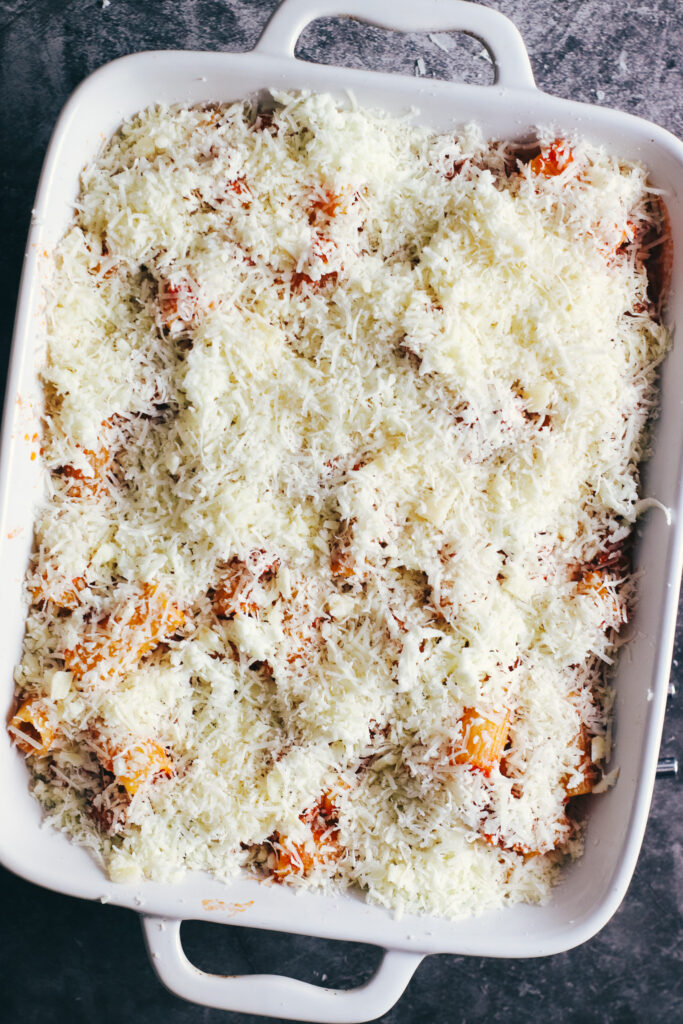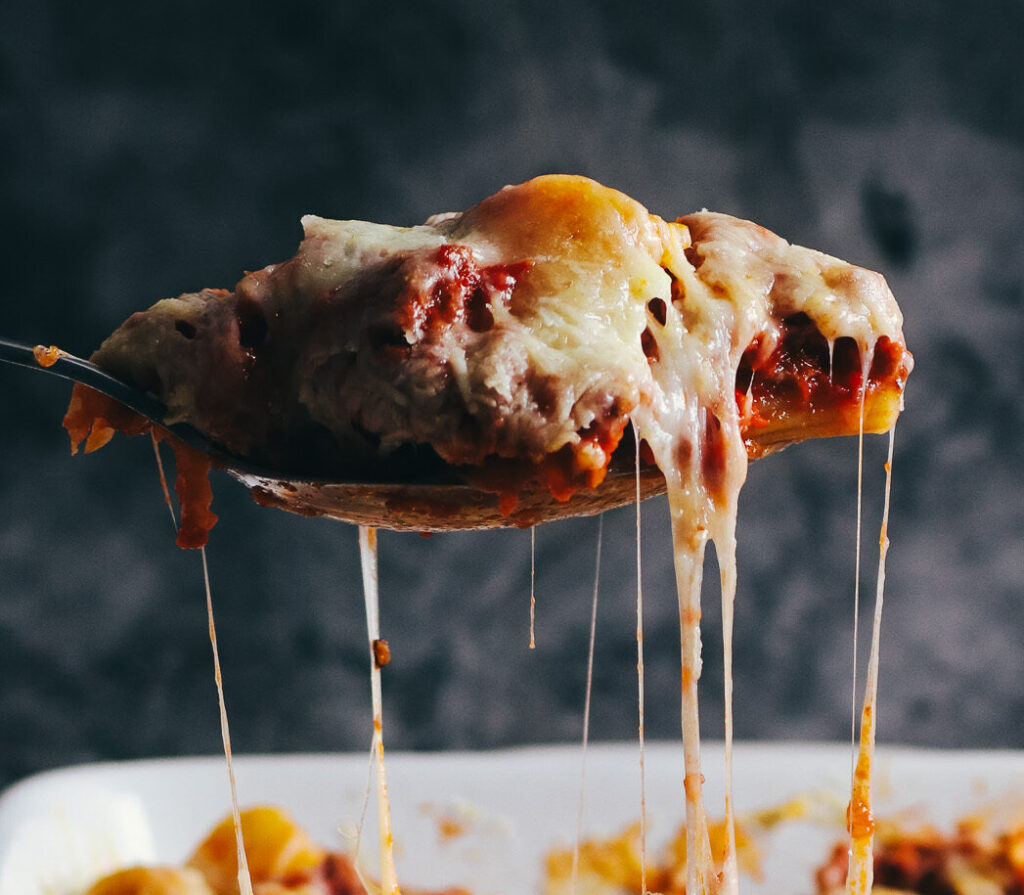This Ultimate Rigatoni Al Forno recipe is a perfect balance of al dente pasta, rich homemade meat sauce, and gooey, golden cheese. Learn the secrets to crafting this authentic Italian baked pasta dish with step-by-step instructions, pro tips, and serving suggestions!

There’s something undeniably comforting about pulling a bubbling dish of Rigatoni al Forno out of the oven—the aroma of slow-simmered tomato sauce, the golden, melted cheese stretching with every forkful, and the perfect bite of pasta coated in a rich, savory sauce.
The first time I had Rigatoni al Forno was at a small local restaurant. A friendly waiter proudly served me a dish that tasted like pure Italian comfort. I instantly knew I had to recreate it at home.
This recipe stays true to those traditional Italian flavors while keeping things simple and approachable for home cooks. Whether you’re preparing a cozy family dinner or hosting friends, this dish is a guaranteed crowd-pleaser.
Let’s dive into the step-by-step process to create this authentic, hearty, and flavorful pasta bake!
What Makes Rigatoni al Forno Special?
Simple ingredients, big flavors – hearty tomato sauce, ground beef, mozzarella, and parmesan.
Perfectly balanced textures – creamy interior with a crispy, cheesy topping.
Easy to customize – make it vegetarian, add spice, or mix up the cheeses.
Great for meal prep – store and reheat effortlessly for leftovers.
Did you know that ‘al forno’ means ‘baked in the oven’ in Italian? This traditional cooking method is used for many classic dishes, from Lasagna al Forno to Eggplant Parmigiana
Ingredients You’ll Need
For the Meat Sauce:
- 2 tbsp olive oil
- 1 small onion, finely chopped
- 4 cloves garlic, minced
- 1 tsp dried oregano
- 500g (1 lb) ground beef or pork
- 2 tbsp tomato puree
- 2 x 400g (14 oz) cans crushed tomatoes
- Salt and pepper to taste
- ½ cup red wine (optional, for depth of flavor)
For the Pasta and Cheese Layer:
- 250g (9 oz) rigatoni pasta
- 200g (7 oz) fresh mozzarella, cubed or shredded
- 100g (3.5 oz) parmesan, grated
- Fresh basil leaves for garnish
Step-by-Step Instructions
1. Make the Meat Sauce
Start by crafting a rich and flavorful sauce that will coat every piece of rigatoni.
Sauté the Aromatics – Heat olive oil in a skillet over medium heat. Add the onion and sauté until soft and translucent (about 3-4 minutes). Stir in the garlic and oregano, cooking for another minute until fragrant.
Brown the Meat – Add the ground beef (or pork) to the pan, breaking it apart with a wooden spoon. Cook until browned and no longer pink.
Simmer the Sauce – Stir in the tomato puree and crushed tomatoes. Add a splash of red wine for extra depth (optional). Season with salt and pepper. Simmer for 30 minutes, stirring occasionally, until the sauce thickens and flavors meld together.
Chef’s Tip: If the sauce gets too thick, add a splash of broth or pasta water to loosen it up.


2. Cook the Rigatoni
Bring a large pot of salted water to a rolling boil. Add the rigatoni and cook for 3 minutes less than the package instructions (it should be slightly under al dente). This prevents the pasta from becoming mushy when baked.
Drain the pasta and toss it with a ladle of sauce to prevent sticking.
Chef’s Tip: Don’t rinse the pasta! The starchy surface helps the sauce cling better.
3. Assemble the Dish
Now comes the fun part—layering all those delicious ingredients!
Mix the Pasta & Sauce – In a large bowl, combine the rigatoni with half of the meat sauce and half of the mozzarella. Stir to coat everything evenly.
Layer It Up – Spread a layer of meat sauce on the bottom of a 9×11-inch baking dish. Add the pasta mixture, then pour the remaining sauce over the top.
Top with Cheese – Sprinkle the remaining mozzarella and parmesan over the pasta.
Chef’s Tip: Want an extra crispy topping? Mix a handful of panko breadcrumbs with melted butter and sprinkle over the cheese before baking.


4. Bake to Perfection
Preheat your oven to 200°C (400°F).
Bake uncovered for 25-30 minutes, until the cheese melts into a golden, crispy layer with irresistible bubbling edges. For an extra crispy top, broil for the last 1-2 minutes.
💡 Chef’s Tip: Let the pasta rest for 5 minutes before serving—this helps the layers set and makes it easier to dish out.
How to Serve Rigatoni al Forno
Pair this rich, baked pasta dish with:
A crisp green salad (Caesar or arugula with balsamic dressing)
Garlic bread or homemade focaccia
Pair it with a bold Chianti or Sangiovese—both complement the rich, tomato-based sauce beautifully
How to Store & Reheat Leftovers
Refrigerate: Store leftovers in an airtight container for up to 3 days.
Reheat: Warm in a preheated oven (180°C/350°F) for 10-15 minutes or microwave individual portions.
Freeze: Assemble the dish (but do not bake). Wrap tightly and freeze for up to 2 months. Bake straight from frozen, adding an extra 10-15 minutes to the cooking time.
💡 Chef’s Tip: Add a splash of broth when reheating to prevent dryness.
Customizing Your Rigatoni al Forno
Make It Vegetarian – Swap the meat for sautéed mushrooms, zucchini, or eggplant.
Spice It Up – Add red pepper flakes for a kick.
Change the Cheeses – Try ricotta for creaminess or smoked mozzarella for a deeper flavor. For the best results, use high-quality mozzarella with good melting properties.
Frequently Asked Questions (FAQs)
No—lasagna is layered with sheets of pasta, while rigatoni al forno is a baked pasta dish with a blended sauce and cheese mixture.
The pasta continues to cook in the oven, so slightly undercooking it ensures it remains firm and doesn’t turn mushy.
.
Absolutely! Assemble the dish, cover it, and refrigerate for up to 24 hours before baking
Final Thoughts: Why You’ll Love This Recipe
Rigatoni al Forno is the ultimate Italian comfort food, perfect for cozy dinners, special occasions, or even meal prepping. It’s hearty, cheesy, and packed with bold, satisfying flavors—everything you want in a baked pasta dish.
I’d love to hear from you! If you try this recipe, let me know how it turns out in the comments below!
📸 Share your dish on Instagram & tag me @ScoffsAndFeasts! I love seeing your delicious creations.
📌 Love this recipe? Pin it for later & share with friends!

Easy Rigatoni Al Forno
Ingredients
- 1 small onion
- 4 cloves garlic
- 2 x 400g tin chopped tomatoes
- 2 tbsp tomato puree
- 500 g beef mince
- 1 tsp dried oregano
- 250 g dried rigatoni
- 200 g mozzarella
- 100 g parmesan
- Fresh Basil Leaves
Instructions
- Begin by sweating over low heat the onion until translucent, then add the garlic and cook for a minute
- Add the oregano and cook for 1 minute
- Add the beef and break up with the back of the wooden spoon, and stir until browned and no pink bits remain
- Add the tomato puree and the chopped tomatoes and stir
- Simmer for 30 minutes until rich and thickened
- Whilst the sauce cooks, cook the pasta until shy of al dente, around 3 minutes short of the recommended cooking time.
- When the pasta and sauce are ready, check for seasoning and adjust, then stir in half of the mozzarella followed by the pasta until well combined
- Transfer to an 11 inch by 9 inch baking dish and top with the remaining mozzarella and parmesan
- Bake at 200℃ for 30 minutes until bubbling and golden
- Garnish with fresh basil leaves and serve
Try Another Recipe

Hi, I’m Paul! I’m a passionate home chef, recipe developer, and food lover who believes that cooking should be fun, rewarding, and stress-free! Through Scoffs & Feasts, I share my favorite tried-and-tested recipes, cooking tips, and troubleshooting advice to help home cooks gain confidence in the kitchen. Whether you’re a beginner or an experienced foodie, I hope my recipes inspire you to try something new.

